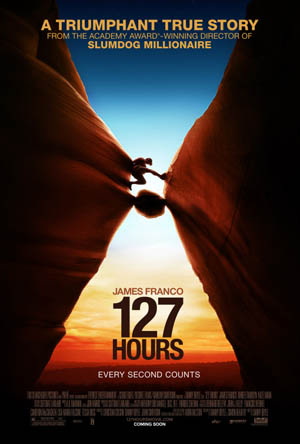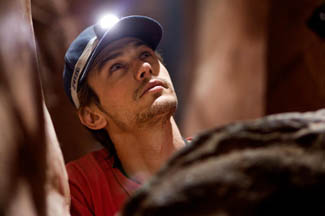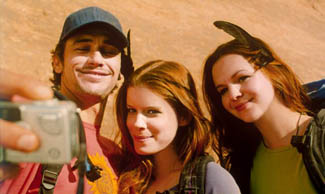- Title: 127 Hours
- IMDB: link

 There are certain movies that become impossible to separate from your specific movie-going experience. 127 Hours is such a movie for me.
There are certain movies that become impossible to separate from your specific movie-going experience. 127 Hours is such a movie for me.
I had heard the advance hype on Danny Boyle’s dramatic and joyous 127 Hours from the festival circuit: People are passing out in the theater because one particular scene in the movie is so intense.
Without giving too much away, the film is based on the true story of college student Aron Ralston (played by James Franco), who found his right arm trapped under a boulder on a solo mountaineering weekend in a remote Utah canyon. The infamous scene occurs towards the end of the film.
Through a combination of sound effects and music (along with the added dread of knowing what was coming for the 80 minutes leading up to the scene), Boyle created a sequence that had me raising one hand in front of my face. There is certainly a bit of a gory element to it, but that is unavoidable—and I humbly submit that it’s not the gore that is so affecting.
Whatever it was, it caused a man in the screening I was in to actually pass out. If there ever was a moment to prove that people all react to movies differently, this was it. The word “seizure” was being thrown around, and I heard he wasn’t the only one who passed out. Regardless, the lights came up, emergency crews were called, and he was helped out of the theater on his feet.
To ignore the power of Boyle’s film after witnessing something like that is just plain stupid. Did I have a similar reaction? No, but I will say this: Boyle doesn’t pull all the obvious heartstring-tugging moves that some filmmakers would have in a movie like this—just some of them.
 He establishes Ralston’s devil-may-care independence through organic means: Ralston doesn’t tell anyone where he’s going and he waves goodbye to his co-worker with his back turned on the way out the door. He plays music in his headphones nonstop and hops around treacherous holes in the ground like he’s invincible.
He establishes Ralston’s devil-may-care independence through organic means: Ralston doesn’t tell anyone where he’s going and he waves goodbye to his co-worker with his back turned on the way out the door. He plays music in his headphones nonstop and hops around treacherous holes in the ground like he’s invincible.
It is only after Ralston becomes trapped that he slows down enough to reflect on his life and assess what his friends and family mean to him. Rather than getting all weepy, Boyle shows us honest flashbacks from a guy who hasn’t taken life too seriously yet. When he does flashback to family events, the moments are fleeting and presented without all the melodramatic fussiness that other directors might resort to.
On the other hand, his “premonitions,” as they are identified in the epilogue text, skirt awful close to manipulative. I preferred thinking they were hallucinations and not having the term defined for me by the film.
The music is snappy, loud, and upbeat for most of the film, which may seem weird for a heavy survival drama, but it’s appropriate for a twentysomething thrill-seeker. Even when things get dire for Ralston, Boyle presents his situation with almost as much humor as pathos. Directorial flourishes like an imagined laugh track are key to breaking up the innate stillness of the story.
 What is remarkable about 127 Hours is that Boyle was able to create a successful forward-moving drama out of the simple elements at hand (no pun intended). Some may cringe at outwardly stylized elements like his use of split screen, but even that bold stroke supports the film’s thesis of how culture can function as a mass of people who barely take the time to look up.
What is remarkable about 127 Hours is that Boyle was able to create a successful forward-moving drama out of the simple elements at hand (no pun intended). Some may cringe at outwardly stylized elements like his use of split screen, but even that bold stroke supports the film’s thesis of how culture can function as a mass of people who barely take the time to look up.
Franco is the perfect leading man for a movie like this because he’s naturalistic, convincing, and likable, even while playing a cocky guy. In lesser hands, Ralston’s confidence could have come across as overbearing, but Franco makes it easy to empathize with him. Plus, holding an audience’s attention for that long in one spot is no small task.
Like Slumdog Millionaire, Boyle is able to make what could be a depressing slog of a movie seem joyous and triumphant. Those who trumpet the director as a master of style aren’t paying attention to how vividly his style supports the storytelling.
Just ask the people who have been physically affected by watching 127 Hours.
